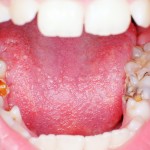
In the Hall Technique carious primary molars are managed by sealing decay under preformed metal crowns without any caries removal, tooth preparation, or local anaesthesia. The aim of the study was to compare the clinical/radiographic failure rates of the Hall Technique (HT) against General Dental Practitioners’ (GDPs) standard (control) restorations.
This split-mouth study involved 132 children, aged 3-10 yrs and GDPs in Scotland. Teeth were randomized to HT (intervention) or GDPs’ usual treatment (control). There were 264 study teeth with initial lesions, 42% of which were radiographically > half-way into dentin, and 67% of which had Class II restorations. Annual clinical/radiographic follow-up data were recorded. Ninety-one patients (69%) had 48 months’ minimum follow-up.
Falure at 60 months are shown in the table.
[table id=8 /]
Overall, there were follow-up data for 130 patients (2-60 mos): ‘Major’ failures: HT, 3 (2%); control restorations, 22 (17%) (p = 0.000004; NNT 7); and ‘Minor’ failures, HT, 7 (5%); control restorations, 60 (46%) (p < 0.000001; NNT 3).
They concluded
Sealing in caries by the Hall Technique statistically, and clinically, significantly outperformed GDPs’ standard restorations in the long term.
Innes NP, Evans DJ, Stirrups DR. Sealing Caries in Primary Molars: Randomized Control Trial, 5-year Results. J Dent Res. 2011 Sep 15. [Epub ahead of print]PubMed PMID: 21921249

Interesting. Why Not. but the thought of Caries being sealed is kind of squirmish > good thing its just temporary.
I believe there is mounting evidence showing that sealing over decay can actually arrest the decay process.
Kerri
You are right and in evidence-based Clincal recommendations from the ADA on the use of pit & fissure sealants published in 2008 (http://jada.ada.org/content/139/3/257.long). In relation to placing sealants over early (noncavitated) lesions stated :
Ref:-
Griffin SO, Oong E, Kohn W, Vidakovic B, Gooch BF, CDC Dental Sealant Systematic Review Work Group, et al. The effectiveness of sealants in managing carious lesions. J Dent Res 2008;87(2): 169–174.( http://bit.ly/obEOhd) .
Now the question becomes, what is the best possible method(s) to create a cross-over effect of this public health measure into the private practice setting?
Anyone know of someone in the USA or Canada who does the Hall Technique?
Hi there, although we’ve had a number of enquiries about the Hall Technique, which has included visits from some North American clinicians and teachers, I’m afraid that we don’t really know how much people are using it in their individual clinical practice.
If it would be helpful to you, we have an updated Hall Manual with a DVD which we would be happy to post to you if you get in touch.
Hi,
I am using the HALL technique in my pedo practice and I’d be glad to receive the manual and DVD. I find that this technique has a place in our child management armamentarium.
Best regards,
Thierry BOULANGER
71, Route d’Henri-Chapelle
4821 Andrimont
Belgium
Hello Thierry, I just read you are going to lecture about “the Hall technique” during a meeting of the BAPD. Well I just want to send my support for that ! I am an enthusiastic user of the technique for many years now. It is good for all dental workers to learn about and perform the Hall technique. Good luck Theirry on 26-04-2014 , I hope you will inspire many collegues!!
I have advocated the use of Hall Technique for the past two years.The “concept of sealing over decay ” has been clinically , a positive mode of treatment